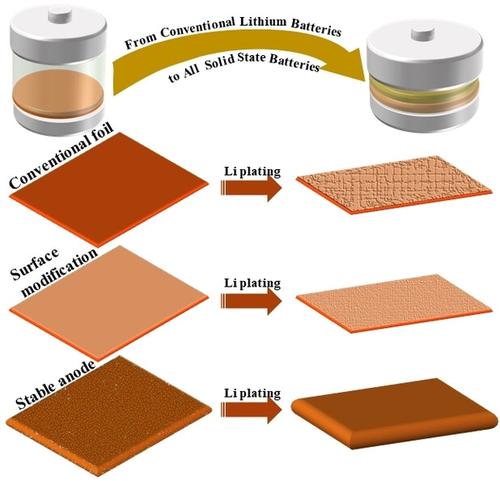当前位置:
X-MOL 学术
›
ChemElectroChem
›
论文详情
Our official English website, www.x-mol.net, welcomes your feedback! (Note: you will need to create a separate account there.)
Developments, Novel Concepts, and Challenges of Current Collectors: From Conventional Lithium Batteries to All‐Solid‐State Batteries
ChemElectroChem ( IF 4 ) Pub Date : 2024-04-16 , DOI: 10.1002/celc.202300739 Ying Zhang 1, 2 , Shenghao Jing 1, 2 , Huaqing Shen 2 , Sijia Li 2 , Yuting Huang 1, 2 , Yuxing Shen 1, 2 , Siliang Liu 1, 2, 3, 4, 5 , Zongliang Zhang 1, 2, 3, 4, 5 , Fangyang Liu 1, 2, 3, 4, 5
ChemElectroChem ( IF 4 ) Pub Date : 2024-04-16 , DOI: 10.1002/celc.202300739 Ying Zhang 1, 2 , Shenghao Jing 1, 2 , Huaqing Shen 2 , Sijia Li 2 , Yuting Huang 1, 2 , Yuxing Shen 1, 2 , Siliang Liu 1, 2, 3, 4, 5 , Zongliang Zhang 1, 2, 3, 4, 5 , Fangyang Liu 1, 2, 3, 4, 5
Affiliation

|
With the innovation and evolution of lithium batteries, different active materials are loaded onto the current collectors, leading to remarkable changes in the components that directly interact with the current collectors. The surface/interface of current collectors in lithium batteries is gradually becoming one of the key factors to improve the overall performance. The thickness, material composition, surface morphology, and intrinsic properties of current collectors are crucial for understanding chemo‐mechanical changes during electrochemical reactions. Despite the widely acknowledged importance of highly efficient electron transportation and improved interfacial performance of current collectors as one of the determinants of exceptional lithium battery performance, insufficient attention has been given to exploring targeted design strategies for current collectors used in various lithium batteries. Particularly, as the development of solid‐state lithium batteries in full swing, there are limited studies focused on current collectors in all‐solid‐state lithium batteries (ASSLBs). This review introduces recent advancements in current collector technology, while highlighting both similarities and differences between negative current collectors applied in conventional lithium batteries and ASSLBs. Furthermore, we propose promising prospects for utilization of alloy materials as next‐generation negative current collectors.
中文翻译:

集电器的发展、新颖概念和挑战:从传统锂电池到全固态电池
随着锂电池的创新和发展,不同的活性材料被装载到集流体上,导致与集流体直接相互作用的组件发生显着变化。锂电池集流体的表面/界面逐渐成为提高整体性能的关键因素之一。集电器的厚度、材料成分、表面形貌和内在特性对于理解电化学反应过程中的化学机械变化至关重要。尽管人们广泛认为高效电子传输和改善集流体界面性能的重要性是锂电池卓越性能的决定因素之一,但对于探索用于各种锂电池的集流体的有针对性的设计策略却没有引起足够的重视。特别是,随着固态锂电池的全面发展,针对全固态锂电池(ASSLB)集流体的研究非常有限。本综述介绍了集流体技术的最新进展,同时强调了传统锂电池和 ASSLB 中应用的负极集流体之间的异同。此外,我们提出了利用合金材料作为下一代负极集流体的广阔前景。
更新日期:2024-04-16
中文翻译:

集电器的发展、新颖概念和挑战:从传统锂电池到全固态电池
随着锂电池的创新和发展,不同的活性材料被装载到集流体上,导致与集流体直接相互作用的组件发生显着变化。锂电池集流体的表面/界面逐渐成为提高整体性能的关键因素之一。集电器的厚度、材料成分、表面形貌和内在特性对于理解电化学反应过程中的化学机械变化至关重要。尽管人们广泛认为高效电子传输和改善集流体界面性能的重要性是锂电池卓越性能的决定因素之一,但对于探索用于各种锂电池的集流体的有针对性的设计策略却没有引起足够的重视。特别是,随着固态锂电池的全面发展,针对全固态锂电池(ASSLB)集流体的研究非常有限。本综述介绍了集流体技术的最新进展,同时强调了传统锂电池和 ASSLB 中应用的负极集流体之间的异同。此外,我们提出了利用合金材料作为下一代负极集流体的广阔前景。



























 京公网安备 11010802027423号
京公网安备 11010802027423号